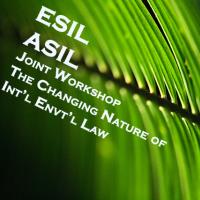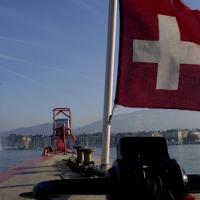ESIL/ASIL Joint Workshop
The Changing Nature of International Environmental Law: Evolving Approaches of the United States and the European Union
Joint Symposium of the European and American Societies of International Law’s International Environmental Law Interest Groups
Graduate Institute of International and Development Studies, 22-23 November 2013
CALL FOR PAPERS (PDF)
The International Environmental Law Interest Groups of the American Society of International Law and the European Society of International Law are delighted to announce that their First Joint Symposium will take place on 22-23 November 2013 at the Graduate Institute in Geneva. The Co-Chairs and Convenors of the Interest Groups join in thanking the Graduate Institute of International and Development Studies and our host, Professor Jorge Vinuales, Director of the Programme on Environmental Studies of the Institute’s Centre for International Environmental Studies, for their kind generosity in providing a venue and refreshments for the Symposium.
Symposium Theme
International Environmental Law is not in the same space that it occupied in 1972 when it burst forth on the international agenda with the Stockholm Conference on the Human Environment. For some time we have been witnessing a fundamental shift in the nature of international environmental law (IEL) from both theoretical and practical perspectives. Many reasons might lay behind this shift. For a start, IEL has had to innovate its way around the “sovereignty barrier” – foundational principles and norms of general international law that continue to uphold a state-based system of international politics and law that is often seen as counter-productive to solving global and regional environmental problems. IEL has done this, in part, through science driven norms, non-consensus decision-making, and a focus on promoting compliance rather than labeling action wrongful with a view to invoking state responsibility.
Then too, IEL has experienced “bottom up” influence from developments in national approaches to environmental protection. Increasingly, IEL has adopted of “second generation” national regulatory techniques including the use of markets, flexibility mechanisms, and privatization. In addition, the underlying reality, which IEL is trying to co-ordinate and steer, is changing. The reality of significant environmental impacts associated with global markets and international investment flows appears to call for a more normatively expansive and inclusive approach. The increasing influence of host of non-state actors such as transnational corporations and expert non-governmental organizations raise questions about participation in and the legitimacy of decision-making and compliance processes.
An emerging new approach to IEL ought to enable us to understand the way various types of soft norms and non-state action influence (or not) the behavior states and key actors beyond states. In this context, most pollution and conservation problems need to be addressed outside of the traditional state system, in what is increasingly described as a multi-level governance framework, with various types of actors having an influence how these norms develop and are supervised. Environmental law approaches and methods have become globalized in various ways, not only by states borrowing from other jurisdictions, but also because e.g. multilateral environmental agreements MEA’s harmonize the way environmental governance is done in various jurisdictions. These environmental law principles and approaches not only travel between national jurisdictions but they also migrate between various levels of governance.
At the same time these macro changes have been influencing the nature of IEL, the approaches to and practice of IEL by the United States and European states is also shifting. Due to their environmental footprint, their economic and geopolitical power, and their technological and financial resources, the US and the EU have a critical impact on the world’s environment, as well as a distinctive ability to shape global environmental politics. Meanwhile, and despite common interests, these two elephants are often said to have developed different approaches to IEL. Notwithstanding strong support for early environmental agreements, the US position over the past two decades has been described as one of disengagement and withdrawal, shying away from binding environmental commitments and favouring unilateral and domestic environmental policies. In contrast, Europe is commonly thought to be a consistent supporter of multilateralism and of legally binding environmental agreements. Additionally, the US and the EU have exhibited marked differences in relation to key IEL principles, from precaution to differential treatment.
The aim of the Symposium, then, is twofold. First, it aims to engage in a search for more sophisticated, nuanced and complex approaches to environmental problem solving and underlying theory of IEL based on the changing nature of the field. Following last year’s Rio+ 20 Conference, we are well placed to consider potential paradigm changers, including whether the concept of sustainable development is still the best idea around which to organize legal protection of the global environment; whether alternative concepts/models might be more effective in stopping environmental harm and improving environmental quality; whether the current preoccupation with “implementation” best serves global environmental protection; and whether international law is up to the regulatory challenges posed by continuing world population growth and increasing consumption.
Secondly, the Symposium also seeks to intensify the transatlantic debate about these important questions, as well as to bring experts from various disciplines and backgrounds to discuss cutting-edge research in the field of IEL. As President Obama begins his second term in office, it seems an opportune time to not only consider the changing nature of IEL, but also to revisit and explore anew the nature, the extent, and indeed the reality of this transatlantic divide and its significance for the development of IEL. Do IEL scholars make too much of US/EU divergences? How do these divergences manifest in specific environmental regimes? What role, if any, do academic, scholarly or theoretical traditions play in the perception of the EU/US divide? Has the Obama administration worked to widen or narrow this divide?
Call for Proposals and Abstracts
The Co-Chairs and Convenors cordially invite the submission of proposals and abstracts on the theme of The Changing Nature of International Environmental Law: Evolving Approaches of the United States and the European Union. Papers presented at the Symposium will be selected through a competitive process. The selection process will be based exclusively on the scholarly merit of proposals received and priority will be given to unpublished papers and work in progress. We welcome proposals from practitioners, diplomats, academics and graduate students that are attentive to one or more aspects of the Symposium theme outlined below.
Each submission should include an abstract of the proposed presentation of no more than 700 words in English or French and a short CV in English or French. Applications should be submitted in a WORD or PDF format. They should be emailed to both Alejandra Torres Camprubi (atorrescamprubi@yahoo.es) and Timo Koivurova (timo.koivurova@ulapland.fi). Please indicate “2013 ASIL/ESIL Symposium” in the subject line of the email.
Deadline The deadline for submission of proposals is Wednesday, 15 May 2013. The outcome of the selection process will be notified to all applicants by Monday, 10 June 2013. After selection, each presenter will be expected to produce a draft paper by Monday, 2 September 2013 for circulation among the other Symposium participants.
Basic Symposium details
It is anticipated that the Symposium will run for one day and a half. It will commence on Friday, 22 November 2013 at noon and will run until 5.30 pm on the first day. It will conclude on Saturday, 23 November 2013, but the day will be full with a 9.00 am start and a 5.00 pm wrap up.
The organizers envision a total of six panels – two panels on the first day and four panels on the second – with each panel comprised of four presenters. The contours of each panel will be determined based on proposals and abstracts that are accepted.
We believe that publishers will be interested in publishing the proceedings of the Symposium in an edited volume. The organizers reserve the right to publish the selected papers. Before publication, all papers will be submitted to peer-review.
Inquiries For all inquiries, please contact Alejandra Torres Camprubi (atorrescamprubi@yahoo.es) and Timo Koivurova (timo.koivurova@ulapland.fi).



